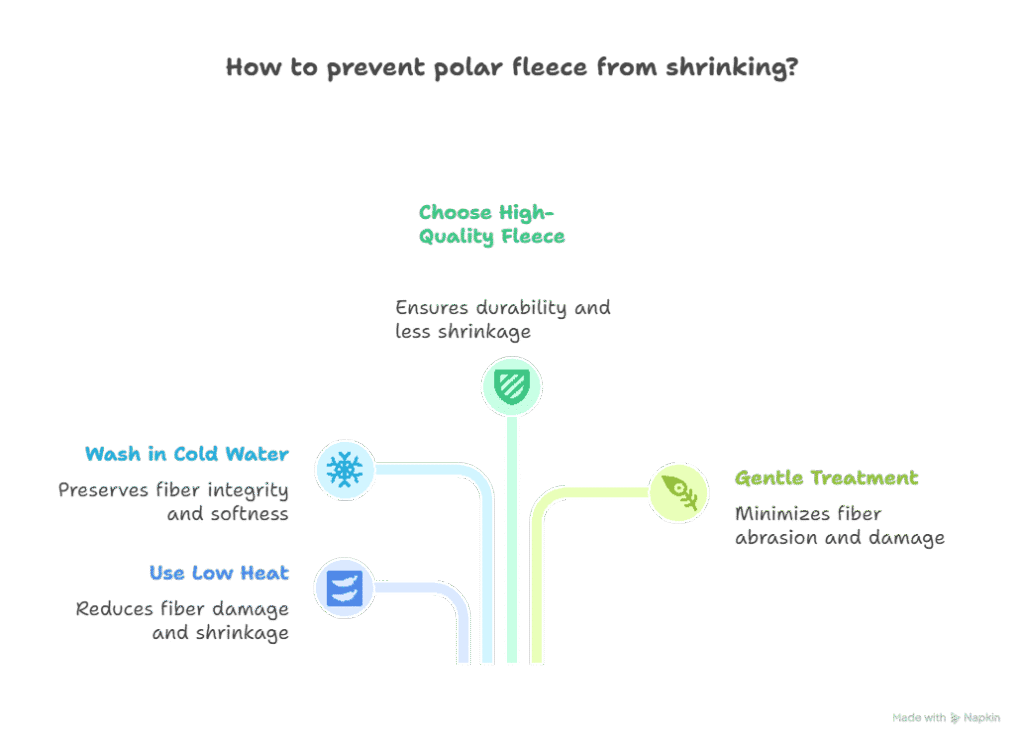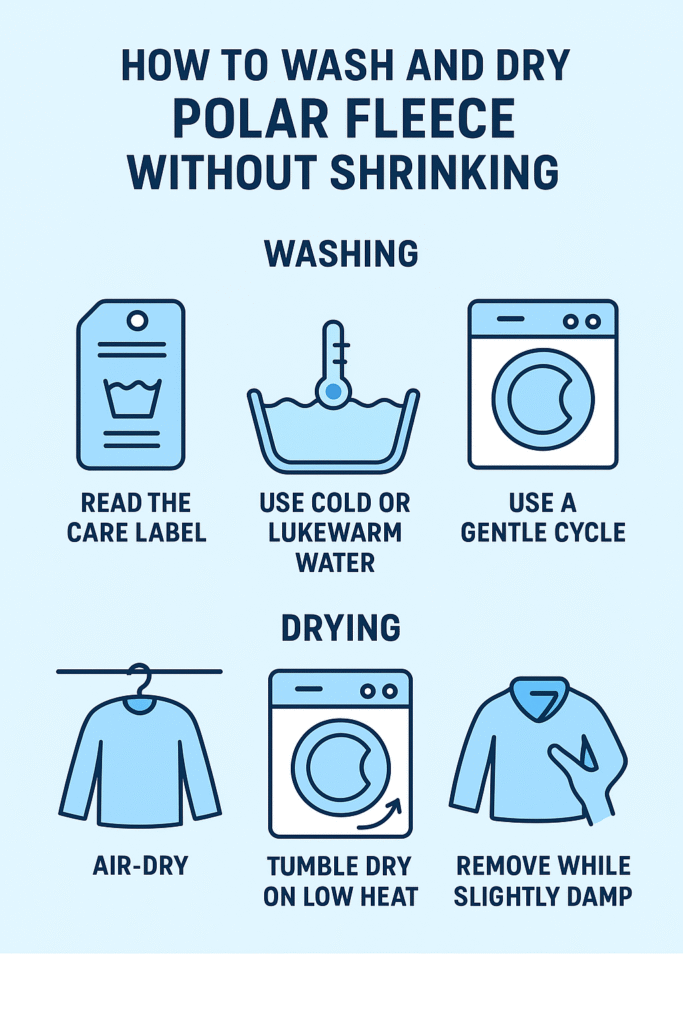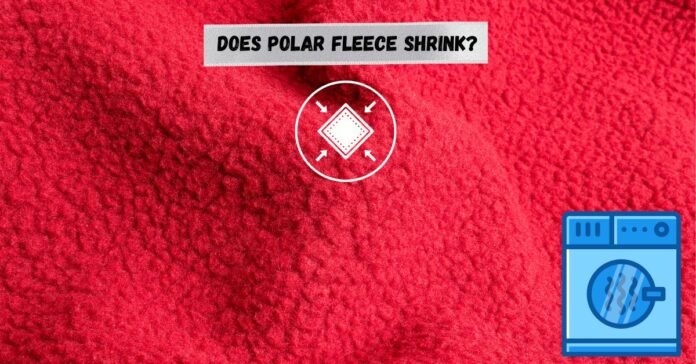Introduction to Polar Fleece-
Polar fleece is a soft, lightweight warm fabric of polyester fibers. It was created in late 1970s as a synthetic substitute to wool, since it had the same insulation qualities without being bulky or unpleasant to wear. Polar fleece has grown into a common fabric option used to make jackets, blankets, hats, and other wintertime clothing because of its great ability to keep a person warm in relation to its weight. The chief benefit is using it compared to natural fibers is that it is very durable and easy to take care. It also shrinks without the need to be dried, withstands moisture, and keeps a steady level of warmth making it suitable in outdoor clothing and day-to-day comfort. However, as it is the case with any material, it has to be taken care of to stay in high quality and avoid appearing as a shrunken, pill-covered and/or having a static effect.
Does Polar Fleece Shrink?
Polar fleece doesn’t shrink easily, but heat is its biggest enemy. It is less shrinking prone than most other types of fabrics such as cotton or wool. The danger largely depends on the ways that you wash and dry it. Although it tends to retain its shape, too much heat in the form of dryers or hot water may shrink or even warp the fiber, so shrinkage or distortion may occur slightly. By using adequate washing/drying practicalities, it is possible to avoid nearly all shrinkage problems and maintain your fleece-based coverings gentle and resilient.
The Science Behind Fleece and Shrinking
Polar fleece is synthetically manufactured polyester fiber, in particular PET plastic. In contrast to natural fibers e.g. cotton or wool, which experience shrinkage because of felting and tightening of fibers, fleece behaves differently. Polyester fibers do not soak-up water and this is why they do not shrink in this way. Rather, the fibers may be distorted or shortened by excessive heat once and for all.
It is primarily caused by the heat. Polyester is a fiber based on plastic materials and much like any plastic, it becomes soft or warped when subjected to high temperatures. The fiber is able to melt or be compressed by being placed on hot dryers or even the iron. This permanent damage causes shrinkage, deformation and lack of softness.
It is the reason that fleece is frequently sold in shrink-resistant form. Through normal washing conditions, it does not shrink easily; however, it can alter it structure through careless drying and ironing. Knowledge of this science can guide you to treat fleece and not damage it.
The Main Factors That Cause Polar Fleece to Shrink

Heat–The Culprit
Dryers stand to be the largest threat to fleece. The high heat tightens polyester fibers and sometimes causes the fibers to partially melt. Not only does it shrink the material, it also can irritate to have a rough feel. If your must to employ dryer, exercise the lowest heat or no-heat mode.
Water Temperature
Hot water isn’t nearly as dangerous as the dryer but it can still have an adverse affect on fleece. Hot or warm water may destroy fibers and make them more likely to shrink during drying. Cold water is the best option for hand washing fleece and it remains soft.
Quality of the Fleece
Not all fleece is alike Good quality fleece such as Polartec®️ have a tight weave and durable fibers that are less prone to shrinking and pilling. Fleece materials of inferior quality though, have the tendency to shrink in size faster, especially after several washings and heating.
Abrasion and Agitation
Although these are not directly shrinking fleece, they weaken the fibers. The surface may be damaged by hard washing, excessive loading of the machine or by repeated friction. Scratched fibers will also not react well to heat and will tend to shrink or distort. The most important thing in maintaining fleece in good condition is gentle treatment of the fleece.
Step-by-Step Guide: How to Wash and Dry Fleece to Prevent Shrinking

Reading the Care Label
There is a label attached to each fleece clothing over how it should be taken care of. With this label you are your own guide to prevent any damage. Before washing or drying, make sure to learn and implement the instructions. Not paying attention to the label may cause you to make errors that decrease the life of your fleece.
Washing Instructions
- Cold or even lukewarm water: will avoid fiber weakening.
- Use gentle cycle: This reduces the amount of fiber stress.
- Avoid softeners in the fabric: Textile softeners can clog up fleece fibers and reduce breathability.
- Turn inside out: Doing this helps to mitigate pilling on the surface.
Such easy-going wash lessons guarantee that you will maintain a fluffy and soft fleece that maintains its size.
Drying Instructions
- Air-Drying: It is the safest choice. Put your fleece out to dry on a rack on a rack or in a shady place.
- Tumble Drying: In case of necessity, depend on the lowest heat setting or a setting titled, Air Fluff (no-heat source).
- Early removal: Take the garment out a little wet and continued to dry on its own.
- Do not apply high temperatures: the most rapid method of shrinking and destroying fleece.
After these rules of drying, shrinkage is avoided and your fleece maintains its new appearance.
What to Do If Your Polar Fleece Already Shrank
The Bad News
If Polar fleece shrinks then it is quite challenging to undo this deformation. The shrinkage is typical of polyester fibers since they are plastic in nature; hence they tend to melt or close up permanently. Unlike wool, fleece is not going to reform easily.
The Gentle Stretch Technique
In the event there was a bit of shrinkage, continue to stretch the fleece as long as it remains dampened. Put the garment out on a table and carefully tug at the material, and mould it back to the correct size. This treatment is of limited success and can only alleviate small shrinkage problems.
Steam and Stretch
Steam can relax the fibers a little bit, and you then have space to re-shape. Scoop a garment steamer, or put an iron into steam setting, but do not put it in contact with the fabric. Spread the fleece by hand as you let the steam permeate. Again, not always leads to the same outcomes, nevertheless, worth the effort.
Be realistic. When the polyester fibers recoil they do not revert completely. Such repairs could tighten fit, but they can not bring the fleece back to its original size. The most effective thing is prevention.
Other Fleece Care Tips
How to Remove Pilling
Use a fabric shaver or pill comb to carefully remove pills. Do not use scissors which will cut the fibers. Shaving fleece regularly will help it look fresh and prevent wear.
How to Store Fleece
Fold fleece garments instead of hanging them, especially if they’re heavy. Hanging can stretch out the shoulders and cause misshaping over time. Store in a cool dry place.
Dealing with Static Cling
Fleece tends to have static cling. Tossing it in the dryer on an air-fluff cycle with a dryer sheet can help reduce static. However, avoid using liquid fabric softeners during washing, as they can reduce performance.
Conclusion-
So, does polar fleece shrink? Well, not usually, but sometimes it does. Fleece won’t shrink much in the washing machine because it’s synthetic, but the dryer and the iron are what usually cause problems. To maintain your fleece in near-perfect shape for years to come, simply wash in cold water, skip the softener, and let it air-dry. You can still fix shrunken fleece, but it’s a difficult process, and if you follow these steps you shouldn’t have to.
Polar fleece is a favorite for a reason. It’s warm, light, and easy to take care of. With just a little attention, you’ll be able to stay cozy and comfortable without having to deal with shrinkage.
Read more>> About coral fleece fabric.
FAQs
Polar fleece is susceptible to shrinking when exposed to high heat in the dryer. The polyester fibers can contract or deform when subjected to elevated temperatures. To prevent shrinkage, it’s crucial to always use a low-heat or air-fluff setting, or even better, opt for air drying your fleece items.
Hot water should be avoided when washing fleece garments or fabrics. Hot water can weaken the polyester fibers, making them more prone to damage in the dryer. To ensure the longevity of your fleece items, it is best to wash them in cold or lukewarm water using a gentle cycle setting.
If your fleece has shrunk, it can be challenging to reverse the process. However, you may attempt to stretch the fabric gently when it is damp or use steam to relax the fibers. While these methods can potentially restore some of the lost size, prevention through proper care remains the most effective solution.

Gives us our time back, gave us family time back. Time-saving champions found. Lifestyle optimization.
Interesting to see that abrasion and agitation can contribute to shrinkage. I usually focus on the heat, but now I’m more aware of how the fabric is handled. Will definitely be more gentle when washing fleece.
[…] is something I always watch out for, especially with cotton fleece. Polyester fleece is less likely to shrink because it is made from synthetic fibers. Cotton fleece, on the other hand, can shrink if exposed […]